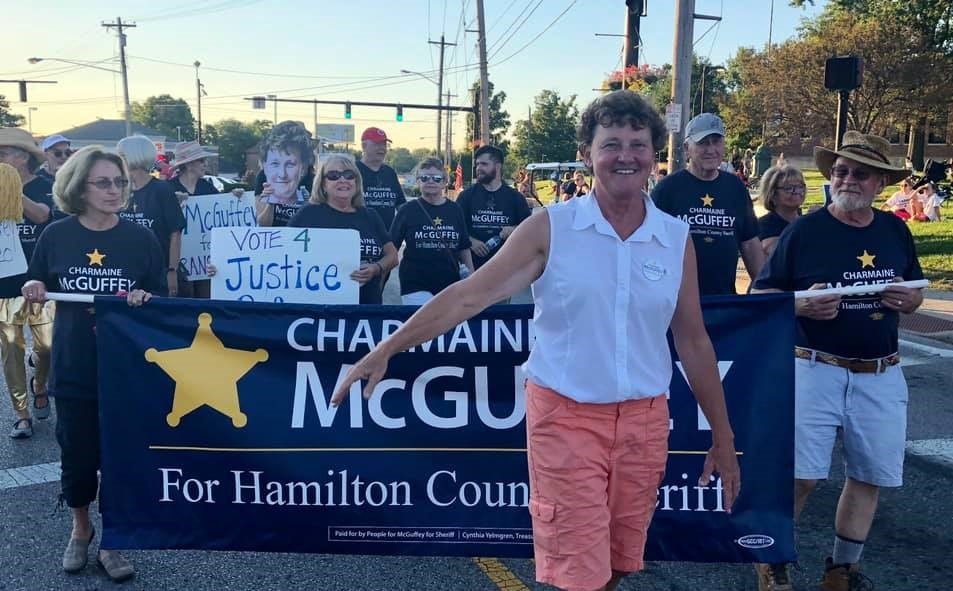Political Report
Cincinnati Voters Oust Sheriff Who Cooperated with ICE and Championed a New Jail
“The solution to the problem of mass incarceration is certainly not more mass incarceration,” said Charmaine McGuffey, who won. In neighboring Greene County, voters rejected a tax increase to build a bigger jail.

“The solution to the problem of mass incarceration is certainly not more mass incarceration,” said Charmaine McGuffey, who won this sheriff’s primary. In neighboring Greene County, voters rejected a sales tax increase that was meant to fund the construction of a bigger jail.
Visit our coverage of 2020 local elections.
In two southern Ohio counties, voters signaled on Tuesday that local officials dealing with jail overcrowding should focus on reducing incarceration, rather than championing expensive proposals to build bigger and shinier jails.
In Hamilton County (Cincinnati), Charmaine McGuffey won the Democratic primary for sheriff, ousting incumbent Jim Neil by a resounding margin: 70 percent to 30 percent.
The tense campaign centered on Hamilton County’s poor jail conditions, Neil’s ties to ICE, and the circumstances of McGuffey’s departure from Neil’s office in 2017.
“People want to embrace criminal justice reform,” McGuffey told the Appeal: Political Report when asked how she interprets her large win. “People are not embracing any more costs to incarceration. … People understand that now is the time for us to get our fiscal house in order, and, morally, to stop mass incarcerating people.”
When Neil first came into office in 2013, McGuffey, a longtime sheriff’s deputy, was promoted as jail director. She held that position until 2017. During that stretch, the sheriff’s office considerably improved the jail’s dismal compliance with state standards. But overcrowding, poor conditions, and allegations of police brutality remained big issues.
Neil advocates building a new jail as a remedy to the current jail’s overcrowding.
But McGuffey opposed the construction of a new jail. “The solution to the problem of mass incarceration is certainly not more mass incarceration,” she reiterated to the Political Report on Wednesday.
It would enable local officials to look away from over-incarceration, she argues. “If there’s a new jail, [the sheriff doesn’t] have to pay attention to it, because now there’s enough room,” she told the Political Report in a March interview, in March. “And I don’t think that is a way to create reform.”
She has proposed reducing arrests and pretrial detention for lower-level offenses, and said on Wednesday that, as sheriff, she “would continue doing what I was doing [as the jail director], and that means bringing real life opportunities to people who are inside our jails… so that they’re not coming right back to our door the moment we open it and let them out.” She added, “There are other ways for us to enforce laws and move people along to deal with addiction, to deal with mental health issues, to deal with homelessness, and we need to work on providing those services.”
In 2017, McGuffey faced an investigatation for fostering a hostile work environment; she declined a demotion, and was fired. She claimed that the investigation was retaliation because she had raised red flags about use of force in the jail. She filed a lawsuit, and an internal report found that she had indeed recommended that an officer be fired over excessive use of force.
She now says that ensuring accountability for use of force would be “at the top” of her priorities, though she argues that there are many circumstances where use of force is justified. “When we have situations of prisoners or people being seriously injured without the justification for those kinds of injuries,” she said, “we are going to have a process by which we evaluate those things. We’re not going to turn our head, we’re not going to sweep things under the rug.”
If McGuffey wins the general election, she would return to the office from which she was fired, this time as its elected leader.
She will face police Lt. Bruce Hoffbauer, who secured the GOP nomination unopposed, in November. Hamilton County has shifted toward Democrats, but the race could be competitive.
Immigration also loomed large over this sheriff’s primary. Neil has long faced protests against his relationship with ICE. He honors ICE’s warrantless requests (detainers), which enable the agency to continue detaining certain people at the local jail beyond their scheduled release.
McGuffey told the Political Report in March that she would no longer honor detainers if elected.
She is the latest in a recent string of sheriff’s candidates who have ousted incumbents on promises to restrict cooperation with the federal agency.
Neil also drew the ire of local Democrats in 2016 when he attended a rally for Donald Trump. McGuffey clinched the endorsement of Hamilton County’s Democratic Party in January.
Originally scheduled for March 17, the primary was delayed until April 28 due to concerns over the novel coronavirus.
The pandemic also changed county officials’ approach to incarceration. In March, the county authorized Neil to release some people who could not afford to make bond, and the sheriff has touted a lower population as a way to fight COVID-19.
McGuffey points to those emergency moves as evidence that the county can implement longer-term decarceral measures.
“It proves the point I’ve been making,” she told the Political Report. “These people can be released from jail without the world falling apart around us, without making us any less safe. We can safely release people from jail, and we are doing it now. I want people to take a look at this model that is being forced upon us, and build upon it in positive ways.”
She added, “It is forcing people to realize exactly what people on the front lines of the reform initiatives have been saying all along.”
Local advocates have indeed argued long before COVID-19 that Hamilton County should reduce its jail population, and that overcrowding threatens public health.
“We don’t want another jail, because you have people who are just sitting here who need the chance to get out,” Chazidy Bowman, a local activist, told the Political Report in March. Paul Graham, executive director of the AMOS Project, a local justice nonprofit, emphasized that many people are arrested in the first place.
“We don’t need to use [a new jail] to warehouse people,” Graham said. “We can’t incarcerate our way out of social services problems.”
—
A similar debate has raged an hour north of Cincinnati, in Greene County.
Here too, local jails are overcrowded and in poor conditions. Here too, the sheriff, Republican Gene Fisher, has championed the remedy of building a bigger jail, with room to detain many more people. Local officials endorsed a plan to increase the county’s detention capacity by 30 percent.
On Tuesday, though, voters overwhelmingly rejected a sales tax increase that would have funded the construction of this new jail.
Greene County Citizens Against Giant Jail Tax, a local political committee, campaigned against the proposal, objecting to pouring money into carceral policies instead of alternatives. “Opioids, homelessness, family violence — taking our social problems and dumping them into the jail doesn’t work,” Pat Dewees, a member of that group, told the Xenia Daily Gazette in March.
Bomani Moyenda, another organizer, echoes this message. “There are a dozen things they could do to reduce the jail population,” he told the Political Report on Wednesday. “They could come up with some pretrial justice services, diversion programs. They could cite people instead of taking people to jail for minor offenses.”
Ohio also held other elections with stakes for criminal justice reform on Tuesday. Former judge Fanon Rucker won the Democratic nomination to be Hamilton County’s prosecuting attorney; he will face Republican incumbent Joseph Deters in November. Deters is a proponent of the death penalty, while Rucker says he would not seek death sentences. In Ashtabula County, meanwhile, former judge Colleen Mary O’Toole secured the Republican nomination to challenge Prosecuting Attorney Cecilia Cooper, a Democrat. O’Toole told the Political Report in January that the opioid crisis expanded the space for criminal justice reform, and amplified the need to “shift away from incarceration.”
—
For Ohio activists who promote decarceration as a better answer to jail overcrowding than building bigger and newer jails, Los Angeles County may prove a budding success story.
Los Angeles officials planned on building a new jail through a $1.7 billion contract, but faced with local pressure they scrapped the idea in August. Then, in March, voters overwhelmingly approved a ballot initiative that directed a local commission to devise a plan to reduce the jail population and reinvest the savings into community services.
Kate Levescont, treasurer of the Greene County Citizens Against Giant Jail Tax, says that a “silver lining to the COVID-19 crisis” may be to jumpstart such conversations in Ohio. “It is perhaps an opportune moment to think about ways to minimize the jail population and make those less expensive investments in diversionary approaches,” she said.
